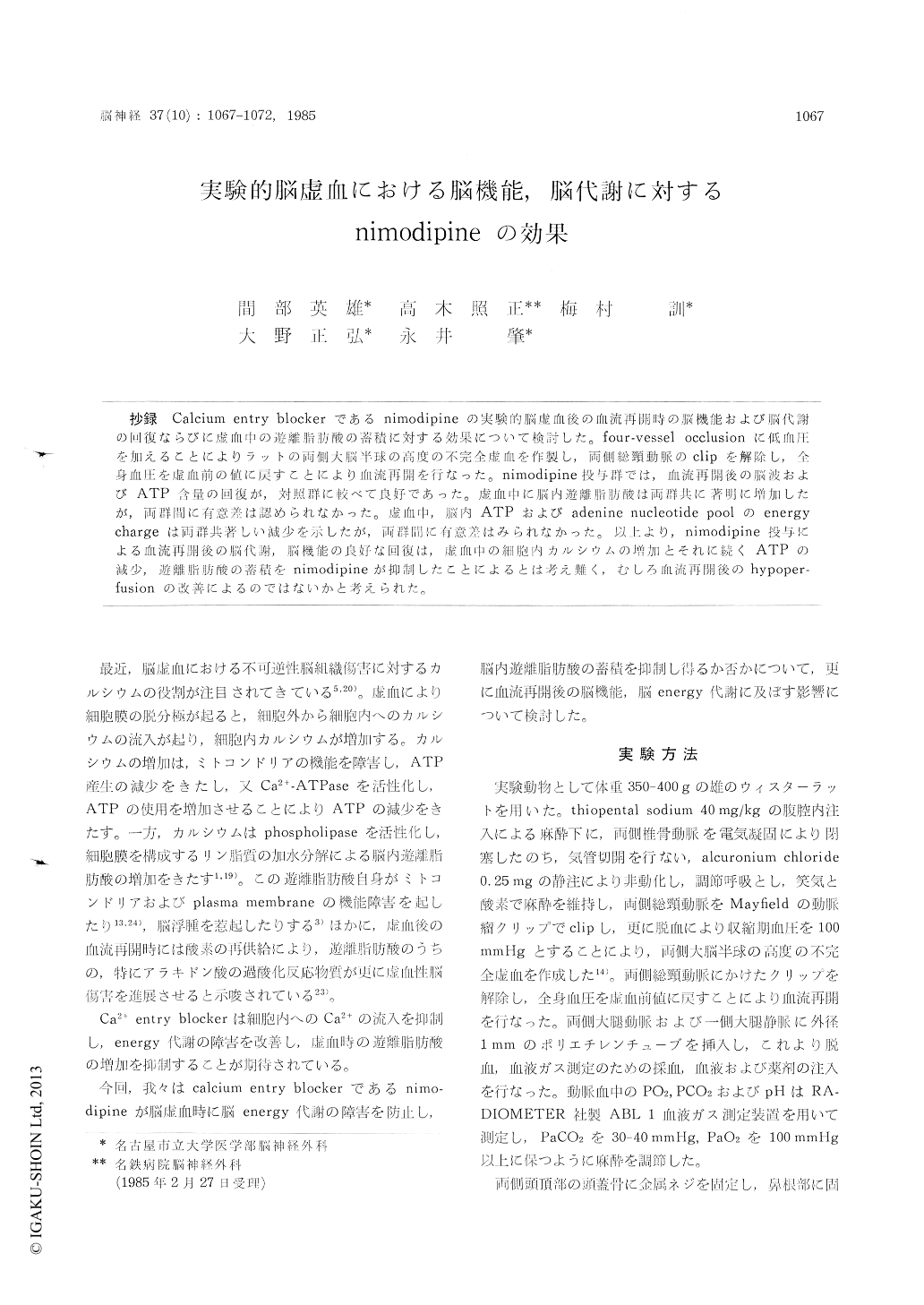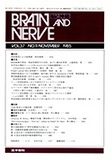Japanese
English
- 有料閲覧
- Abstract 文献概要
- 1ページ目 Look Inside
抄録 Calcium entry blockerであるnimodipineの実験的脳虚血後の血流再開時の脳機能および脳代謝の回復ならびに虚血中の遊離脂肪酸の蓄積に対する効果について検討した。four-vessel occlusion に低血圧を加えることによりラットの両側大脳半球の高度の不完全虚血を作製し,両側総頸動脈のclipを解除し,全身血圧を虚血前の値に戻すことにより血流再開を行なった。nimodipine投与群では,血流再開後の脳波およびATP含量の回復が,対照群に較べて良好であった。虚血中に脳内遊離脂肪酸は両群共に著明に増加したが,両群間に有意差は認められなかった。虚血中,脳内ATPおよび adenine nucleotide pool の energychargeは両群共著しい減少を示したが,両群間に有意差はみられなかった。以上より,nimodipine投与による血流再開後の脳代謝,脳機能の良好な同復は,虚血中の細胞内カルシウムの増加とそれに続くATPの減少,遊離脂肪酸の蓄積をnimodipineが抑制したことによるとは考え難く,むしろ血流再開後のhypoper—fusionの改善によるのではないかと考えられた。
Ischemic deporalization of cell membranes is associated with a precipitous influx of calcium from the exracellular to the intracellular compart-ment, and it is suggested that increased intracel-lular calcium in ischemic brain leads to an activa-tion of phospholipase and to increase of the con-centration of free fatty acids, in particulararachidonic acid, with energy depletion.
The objective of the present study is to test whether calcium entry blocker, nimodipine, pre-vent increase of free fatty acids and metabolic disturbances during ischemic period, and promote functional and metabolic recovery after recircula-tion.
Severe forebrain ischemia in rats was induced by four-vessel occlusion with reducing the systolic arterial pressure to 100 mmHg. After forebrain ischemia had been maintained for 30 minutes, recirculation was started by removal of the arterial clamps of bilateral common carotid arteries and by increasing systemic blood pressure to the preischemic level. The EEG was continuously recorded from gold-coated screws inserted bila-terally in the parietal bones with the tips in extradural position, against a reference inserted prefrontal bone. Analysis of power spectrum of EEG activity was done by Berg Fourier Analyser. The brains were frozen in situ with liquid nitrogen before, during and after ischemia and then chisel-led out during irrigation with liquid nitrogen. Concentrations of ATP, ADP, AMP and free fatty acids in brain tissue were determined with high performance liquid chromatography. Nimodipine, 10 pg/kg, was given intravenously 2-3 minutes before induction of ischemia, and an infusion of 1 fig/kg/min was continued during ischemic andpostischemic periods.
EEG power spectrum in nimodipine-treated ani-mals contained higher percentage of alpha and beta waves compared to in control animals, while delta wave was lesser in nimodipine-treated ani-mals than in controls. During ischemic period, free fatty acids (palmitic, oleic, stearic, arachido-nic and docosahexaenoic acids) in brain tissue remarkably increased, but there were no signifi-cant differences between treated and untreated animals. After 30 minutes of ischemia ATP level in untreated animals was was 0.19±0.03μmol/g (mean ± SE), in nimodipine-treated 0.27 ± 0.06 μmol/g (mean±SE), and there was no significant difference between treated and untreated groups. At 120 minutes following recirculation, ATP level in control animal was 2.13±0.08 tunolig (mean± SE) and 2.62±0.10μmol (mean±SE) in nimo- dipine-treated animals. Thus, recovery of ATP level was significantry better in nimodipine-treated animals than in control animals (p<0.01).
Therefore, it is suggested that promotion of functional and metabolic recoveries after recircula-tion in the nimodipine-treated animals is not due to prevention of accumulation of free fatty acids and depletion of ATP level during ischemia, but probably due to improvement of postischemic hypoperfusion.

Copyright © 1985, Igaku-Shoin Ltd. All rights reserved.


